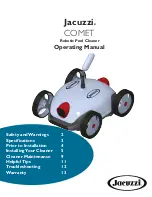
5.1.1 Mounting instructions
– Dimensions for installation and conections are
given in table 2 paragragh 1.2.1 and fig. 2a
– The pump can be mounted up to 5 metres below
and up to 2 metres above pool water level, mea-
sured from suction inlet connection (Fig.2).
– The most suitable mounting level is below the
pool water level. The pump then operates under
flooded suction (without suction lift).
– On priciple, suction lines should be as short as
possible.
– If it is necessary to mount the pump above pool
water level, the suction pipe (from pool to the
pump) should preferably be run full-length hori-
zontally below water level and only rise directly
at the pump. The suction line will then, on shut-
down of filter pump, only slightly be emptied.
– If the sand filter is placed above water level and
with an additionally long suction run, the circula-
ting pump should preferably be mounted sepe-
rate from the filter close to the pool below water
level.
– When operating with a suction lift, light-weight
but positively sealing non-return valve should be
fitted at the lowest point of the suction line. They
will assist in maintaining the water level in the
suction line during standstill of the filter plant.
These checkvalves must, for the ease of clea-
ning, be easily accessible and removable.
– Total lengths of the circulating pipework must not
exceed 30 metres.
5.2 Electrical wiring
5.2.1 Safety information
As an effective protection against disas-
trous effects of earth fault currents it is
required to install an earth fault circuit
interruptor (Fl-switch) for the total elec-
trical circutery of the pool system. Trip
current 30mA.
An all-pole isolation switch (min.contact gap 3mm)
must be installed in the power supply cable.
As an protection from excessively high shock vol-
tage it is required to connect all metallic parts at
pool bottom and walls with a potential compensa-
tion wiring. This copper wire, minimum size 10 mm
2
CU, should be conncted to a specially set and ear-
thed potential compensating busbar, which is to be
seperately connected to the earth wire of the power
supply.
The earthing resistance of the potential compensa-
ting wire must be less than 800 ohms in order to
restrict the shock voltage to less than 24 V in case
of a fault.
A switchbox must be provided on site by others to
ensure the thermall overload contacts (WSK) of the
pump motor to be effective.
5.2.2 General information
– Electrical work to be carried out by
qualified and licensed electricians in
strict conformity to ruling national stan-
dards and local regulations..
– Check available power supply data
– Observe pump name plate data
– Power supply fuses: 10A, inert action
– Baseplate (on site by others) to be earthed
– Degree of protection: IP 54
– The pump motor is internally equipped with ther-
mal overload contacts (WSK). Ensure that re-
pective terminals are available in the filter switch-
box.
5.2.3 Terminals
Effect on-site wiring according to the wiring dia-
grams:
Fig. 3: Motor terminal block for single phase-
230/240V
Fig. 4: Motor terminal block for three phase- 230V
(
V
)
Fig. 5: Motor terminal block for three phase-
400/415V (Y)
6 Commissioning (Fig.1)
– Pool and balance tank (if applicable) must be fil-
led
– Close all insolating valves
– Undo cover nut (Item 3) of the lint strainer (Item
2) with the aid of the ring spanner provided and
remove strainer cover (Item 4).
Lint strainer must be filled with after
draining the pipe system. This en-
sures priming ability of the pump in
case of filter plant installation above
pool water level.
– Reposition of lint strainer cover and secure by
tightening with the ring spanner.
Pump must never be run without the
lint strainer (Item 9)!
– Open isolating valves.
– Switch on pump or switchbox respectively.
– Direction of rotation check: Only required in the
case of three phase motors. Briefly switch-on
pump. The pilot light on the terminal box (Item 6)
must be off. If it is on, the pump rotates in the
ATTENTION!
ATTENTION!
ENGLISH
10
Содержание Wilo-FilTec FBS
Страница 2: ...Fig 1 Fig 2 Fig 2a...
Страница 3: ...Fig 5 Fig 4 Fig 3...






























